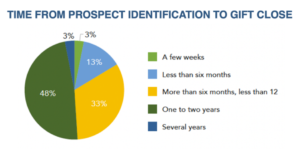We use cookies to ensure that we give you the best experience on our website. By continuing to use this site, you agree to our use of cookies in accordance with our Privacy Policy.
 Login
Login
Your Role
Challenges You Face
results
Learn
Resources
Company
Do you really need MORE gift officers to raise more money?


Too many nonprofits mistakenly assume that the best way to increase major gifts fundraising is to hire more major gifts officers.
To a point, this might be true. But it’s simply not cost-efficient. And because of turnover, it’s hard to sustain.
Plus, remember what happened to Blockbuster. They thought the best way to increase revenue was to open more stores. Then technology (Netflix) showed them a better way.
Sadly, too many nonprofit leaders don’t understand what’s involved with major gifts fundraising or how to get the best out of their people—even the all-stars. Too often, they hire more staff before an existing team is optimized.
For example, suppose you have a team of five major gifts officers. What is likely is that you have one all-star, a couple of average ones, and a couple below-average ones.

Typical gift officer team
The challenge is to identify which is which, keeping in mind that major gifts often require six months to two years for transactions to close (according to the 2020 Major Gifts Fundraising Benchmark Study). In that time, how many great prospects have your poor performers driven away, ignored or lost?

The 2020 Major Gift Benchmark Study is available at no cost here.
Finding and hiring top talent for a position like a major gifts officer isn’t simple, easy, or cheap
Depending on the specifics, here’s a list of hard and soft costs you incur every time you look to hire a new major gifts fundraiser:
- Recruitment costs: advertising, recruitment firm commissions, interviewing time
- Training costs: time spent on-ramping and getting them up to speed
- Management costs: your management time is money, too
- HR costs: performance plans, onboarding, offboarding
- Legal costs: especially because fired workers sometimes sue their former employers
- Equipment and facility costs: computers, office, cybersecurity
- Travel costs: air, train, car, hotel, dining and per diem
- Benefits costs: health insurance, vacations
Again, these are ancillary costs that come with having to hire for any position of great importance and with high stakes. But it’s still money you wouldn’t have to spend if the original person didn’t quit. The most serious costs show up as lost donors and lost opportunities, as already mentioned.
So, in major gifts fundraising, turnover is bad
Destructive, really.
And yet so depressingly frequent.
A better way?
What if there was a way to multiply your revenue while retaining your best staff, attracting the best fundraisers, and lowering or maintaining your major gifts fundraising costs? Fundraising automation can do this.
It can help one fundraiser perform like nine while supporting their desire to stay focused on what they do best—meeting with philanthropic-minded supporters when those donors are ready for a relationship.

With fundraising automation, one fundraiser can perform like nine.
If you leverage technology properly, you can build a more cost-efficient and more effective team.
I know it sounds crass, but you’ll want to consider eliminating your low performers while keeping your all-stars delighted to work for your nonprofit. Why? Because that would improve staff morale while solving all kinds of revenue problems, wouldn’t it?
Plus, imagine how much money you’d raise if you could attract the best fundraisers to join your team!
So why not optimize before hiring?
I think every donor, supporter, advocate and volunteer would prefer that you run your business as efficiently as possible.
They’d want you to leverage technology to maximize staff performance. Especially if there was no risk because it came along with a 10:1 return on investment guarantee, or your money back.
Let me know if you’re interested in hearing more about how that works.
Not ready for that yet? Need more support for your case? Ok, let’s go!
There are four tasks you can automate to relieve your gift officers of the burdens related to their most pressing challenges:
If you automate these four essential tasks, you will attract and retain more of the best fundraisers. Your team will feel supported and valued, and not like they’re wasting all their time staring at screens, calling unqualified leads, messing around with lists, chasing false positives on wild goose chases or bothering qualified donor prospects when the timing simply isn’t right.
Your staff will be able to focus more energy and time on what they do best: meet with philanthropic-minded people to help facilitate their giving when it’s convenient for them.
Plus, automating these four tasks enable you to better identify your poor performers and remove them. After all, poor performers don’t generate enough revenue to justify their position. They are the weak links that bring down your team and increase your other costs because they require additional oversight from management and HR.
So, removing them will save you money while allowing your average gift officers to become above average—especially if they are fed highly qualified prospects who are ready for meaningful engagement. Fundraising automation can support that.
More revenue per employee
Remember, Netflix leveraged technology to generate 32 times more revenue per employee than Blockbuster. You can do that too! As the diagram below shows, you can generate more revenue with fewer people.
If you make this work, your expenses will be about the same. You will still have five people, but now all of them will perform better. They will generate more revenue while costing you less time, money, and frustration.
With fundraising automation, all your major gifts officers will be able to perform at above-average level. Plus, they’ll stay put. They won’t seek other opportunities because, at your organization, they have a chance to become the fundraisers they always wanted to be.
Isn’t that what you want, after all?
And isn’t that what your donors want too?
In my next post I’ll outline the 3 types of marketing automation and which one you really should invest in first and most.
Related Posts:
>> Can your nonprofit organization afford to invest in marketing automation?
>> Top 10 ways marketing automation helps nonprofits raise more money for less
>> How to put marketing automation to work for your nonprofit’s fundraising
LIKE THIS BLOG POST? LEAVE YOUR COMMENTS BELOW AND/OR SHARE IT WITH YOUR PEERS!
Get smarter with the SmartIdeas blog
Subscribe to our blog today and get actionable fundraising ideas delivered straight to your inbox!


I absolutely concur with your POV. Of course, we do need to train and support the newer entrants in the team over a period of time. All said and done, one can sense and observe trends from these employees. IMHO, as a responsible Supervisor I offer additional mentoring and training. However, if the trend still (the numbers will speak for themselves) continues one needs to make objective and hard decisions to optimize overhead, as well as to ensure the morale and success of the team.
[…] Do you really need more gift officers to raise more money? […]